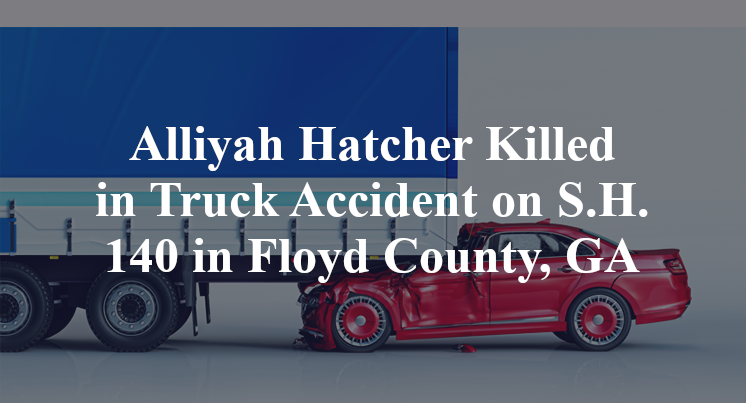Alliyah Hatcher Killed in Truck Accident on S.H. 140 in Floyd County, GA
Floyd County, GA — April 2, 2025, Alliyah Hatcher lost her life following a truck accident that took place in the westbound lanes of State Highway 140.
According to authorities, 28-year-old Alliyah Hatcher was traveling in a westbound Hyundai Elantra on State Highway 140 at the State Highway 53 intersection when the accident occurred.

Both the Elantra and an 18-wheeler with a trailer in tow were apparently attempting to make a left turn. Officials indicate that, for as yet unknown reasons, a collision took place between the front-end of the Elantra and the rear-end of the 18-wheeler.
Hatcher apparently became entrapped in the wreckage and had to be extricated by emergency personnel. Once freed from the wreckage, she was transported to a local medical facility by EMS in order to receive immediate treatment for the injuries she incurred due to the crash. However, she was ultimately unable to overcome the severity of her injuries, having later been declared deceased. Additional information pertaining to this incident is not available at this point in time. The investigation is currently ongoing.
Commentary
When a passenger vehicle collides with the rear-end of an 18-wheeler during a turning maneuver, most people assume it was the smaller vehicle that caused the crash. But from my perspective, that assumption often overlooks the complexity of how these wrecks unfold—especially when both vehicles were attempting to turn at the same intersection.
One of the first questions that needs to be asked here is whether the truck’s position and movement during the turn gave the driver of the Elantra a fair opportunity to react. Large commercial trucks require more space and time to complete turns, and they often swing wide, take up multiple lanes, or move more slowly than other drivers anticipate. If the truck moved unpredictably or failed to signal clearly, that could have created confusion or even trapped the Elantra in a situation with no safe way out.
Another important issue is visibility. A trailer’s rear-end, particularly at night or in low-light conditions, must be equipped with working lights and reflective markings so that other drivers can see it clearly. I’ve handled cases where trailers were poorly lit, had faded or missing reflective tape, or were positioned in a way that made them hard to detect until it was too late. If any of those conditions were present here, then it may have played a major role in what happened.
There’s also the matter of timing. If both vehicles were making a left turn, were they part of the same turning movement, or did the truck complete its turn ahead of the Hyundai and stop unexpectedly? Was the Elantra following too closely, or did the truck stop in an unexpected spot that wasn’t part of the designated turning lane? These are details that need to be reconstructed carefully using dashcam footage, black box data, and witness accounts—assuming they’re available.
And if the 18-wheeler was operating under a commercial carrier, that opens the door to even more questions. Was the driver properly trained on how to execute complex turns in mixed traffic? Did the company provide route planning that accounted for the challenges of turning at this intersection? Were the vehicle’s lights and reflectors inspected and documented as part of regular maintenance? These are not minor concerns—they can directly impact who should be held responsible.
From where I sit, a fatal crash like this deserves more than a quick assumption about fault based on vehicle size or position. It requires careful analysis of what each driver was doing, how the truck was maintained and operated, and whether any part of the incident could have been prevented with better equipment, planning, or communication. That’s the only way to hold the right parties accountable and ensure that those affected by the wreck receive the clarity and closure they deserve.

“These are essential reads for anyone dealing with the aftermath of a truck wreck”– Attorney Cory Carlson